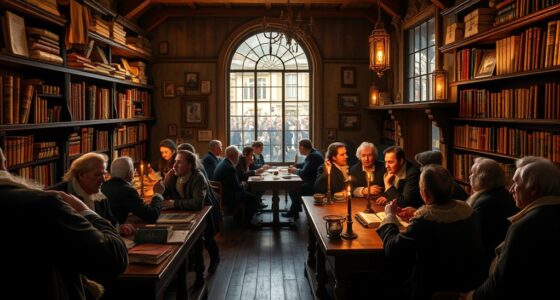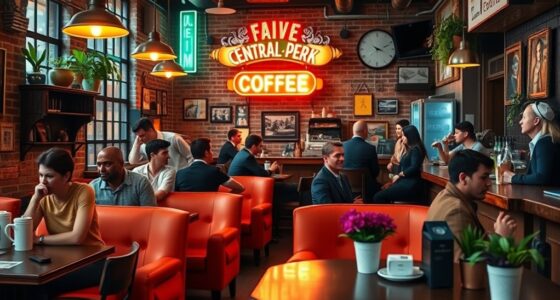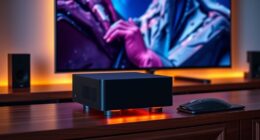In film noir, the late-night diner coffee scene highlights themes of moral ambiguity and personal reflection. You notice how the flickering neon lights and quiet ambiance create a moody, introspective atmosphere. The coffee becomes more than just a drink; it’s a symbol of vulnerability, uncertainty, or resolve. This setting reveals inner conflicts without words and enhances the gritty, poetic tone. Keep exploring how these visual cues deepen the story beneath the surface.
Key Takeaways
- The late-night diner with coffee symbolizes solitude, introspection, and moral ambiguity central to film noir narratives.
- Coffee acts as a visual cue for vulnerability, tension, or resolve, emphasizing noir characters’ internal struggles.
- Dim lighting and neon ambiance create a moody environment that reinforces themes of secrecy and moral gray areas.
- The diner setting facilitates character development through subtle gestures, posture, and silence rather than dialogue.
- Coffee scenes often mark pivotal moments of realization or moral choice, highlighting the existential themes of noir films.

Few images capture the essence of film noir quite like the solitary figure sipping coffee in a dimly lit late-night diner. This scene instantly immerses you in a world of shadows, secrets, and moral ambiguity. The quiet hum of the neon lights outside, combined with the flickering fluorescent bulbs overhead, sets a moody atmosphere that draws you into the narrative without a word. As you observe the character at the counter, you realize that the coffee isn’t just a beverage — it’s a tool for mood setting. It establishes a tone of introspection and loneliness, heightening the sense of isolation that’s central to noir’s aesthetic. The dim lighting and sparse surroundings evoke a sense of foreboding, hinting at the complex, often dangerous world the character navigates.
This environment plays a pivotal role in character development. The way you see the person in the diner—lost in thought, wary, perhaps a little guarded—tells you a lot about their inner life. The act of drinking coffee becomes a subtle gesture that reveals vulnerability, determination, or even despair. You notice how their posture, their glances, and their silence communicate more than words ever could. The diner setting strips away extraneous details, forcing you to focus on the character’s internal struggles and moral dilemmas. In this quiet space, their layers unfold, and you start to understand the motivations behind their actions. The scene becomes a canvas for revealing character depth, making the coffee and dim lighting integral to storytelling. Additionally, the visual cues provided by the setting reinforce the film noir themes of moral ambiguity and existential doubt.
Furthermore, the late-night diner coffee scene encapsulates the noir theme of ambiguity—good and evil, right and wrong, hope and despair coexist in this shadowy world. The environment amplifies these tensions, creating a mood that’s both gritty and poetic. You’re drawn into this world that’s neither black nor white but a complex spectrum of shades of gray. The coffee, the lighting, and the setting work together seamlessly to deepen your connection to the characters and the story. They serve as visual cues that signal a turning point, a moment of introspection, or a realization. The late-night diner becomes more than just a backdrop; it’s a space where characters confront their truths, and you, as the viewer, become a silent witness to their unfolding stories.
Frequently Asked Questions
Why Is Coffee Associated With Noir Protagonists’ Moral Ambiguity?
You see, coffee symbolizes the urban decay and existential dread noir protagonists face daily. It’s their refuge amid chaos, fueling long nights filled with moral ambiguity. By sipping coffee, they confront their inner struggles and uncertain futures. The dark, gritty setting mirrors their internal conflicts, making coffee a visual cue for their moral complexity. It’s not just a drink, but a symbol of their gritty, ambiguous world.
How Did the Late-Night Diner Become a Noir Cinematic Staple?
You see, the late-night diner became a noir staple because its stark, neon-lit aesthetic mirrors the shadows cast on characters’ morals. The diner’s everyday chaos feels like a battleground where secrets brew over coffee, symbolizing the caffeine-fueled tension within. It’s a place where characters confront their dilemmas, blending gritty realism with moody ambiance, making it the perfect backdrop for noir’s morally ambiguous tales.
Are There Real-World Parallels to the Noir Coffee Trope?
Yes, there are real-world parallels to the noir coffee trope. You find urban caffeine scenes in your morning routines, where coffee shops serve as hubs for reflection and connection, much like noir films’ late-night diners. These spaces become your urban sanctuaries, offering solace and clarity amid chaos. Just like in movies, coffee fuels your day, creating a gritty yet comforting atmosphere that mirrors the timeless allure of noir’s iconic coffee moments.
What Psychological Effects Does Late-Night Coffee Consumption Have on Characters?
When you drink late-night coffee, you boost your mental alertness, helping you stay focused on tough decisions or complex puzzles. However, it can also heighten emotional vulnerability, making you more sensitive or anxious during quiet moments. You might feel a rush of energy, but that can come with crashing later, affecting your mood. So, while coffee sharpens your mind, it can also amplify your emotional responses.
How Does Lighting Influence the Noir Diner Coffee Atmosphere?
You notice how lighting sets the mood in a noir diner with neon glow casting vibrant colors and shadow play creating deep contrasts. This interplay heightens the sense of mystery and tension, making every corner feel alive with secrets. The neon glow draws your eye, while shadows obscure details, emphasizing the gritty, uncertain atmosphere. It’s this lighting that immerses you in the noir vibe, making the coffee scene feel both alluring and ominous.
Conclusion
As you sit in that dimly lit diner, sipping your coffee, you realize how film noir’s shadows and secrets linger in every mug. The late-night brew becomes more than just a drink; it’s a quiet companion through life’s darker moments. In these moments, you find a subtle comfort, a gentle reminder that even in the gloom, there’s a warmth waiting to be savored. Sometimes, all you need is a little dark brew to keep going.









